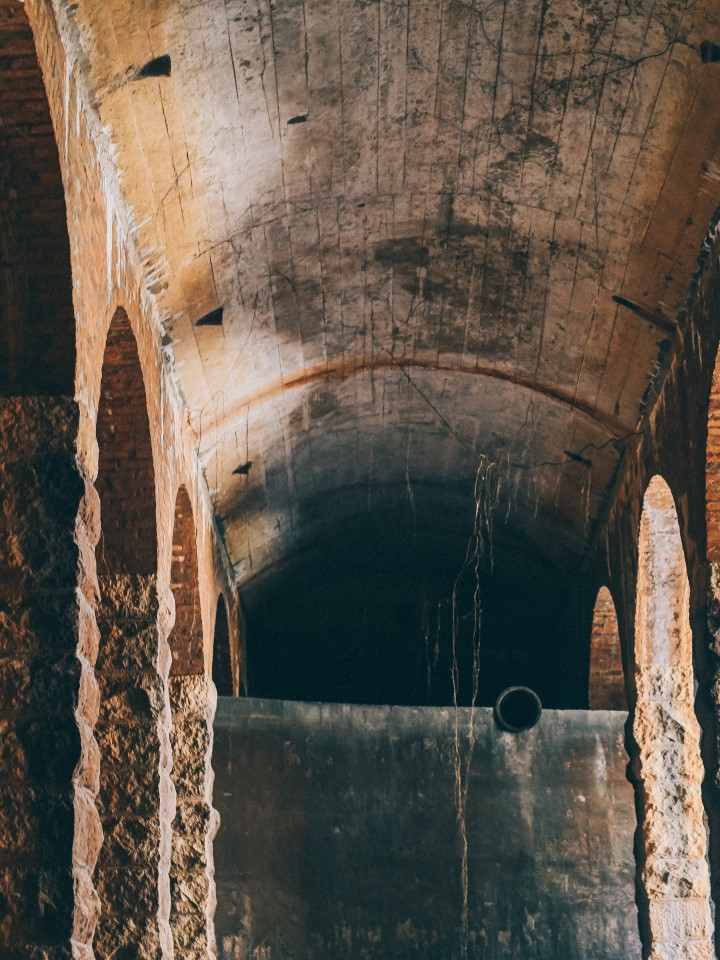
Located on Mission Hill in Sham Shui Po, the Ex-Sham Shui Po Service Reservoir was rediscovered in 2020 after being decommissioned for more than a few decades. Featuring European-style granite piers and red brick arches imitating Roman civil engineering works, the structure offers us a precious glimpse of Hong Kong’s water supply history over the past 100 years.
The Ex-Sham Shui Po Service Reservoir was confirmed as a Grade 1 historic structure by the Antiquities Advisory Board in 2021. From 1 August 2024, visitors can see the historic structure without prior appointment. You may also join the guided tour launched by the Water Supplies Department to learn more about the water supply history in Hong Kong.
A century-old service reservoir in Kowloon
The Ex-Sham Shui Po Service Reservoir was built to increase water supply in the early years of Hong Kong. The main source of public water supply on the Kowloon Peninsula was the deployment of underground water, which became insufficient as the population grew. In 1902, the Hong Kong Government launched the Kowloon Waterworks Gravitation Scheme, which entailed the construction of the Kowloon Reservoir and Catchwaters, the Tai Po Road Filter Beds and the Ex-Sham Shui Po Service Reservoir, known as ‘Kowloon Tong Service Reservoir’ at that time, as well as connecting water pipes of various sizes with the service reservoirs to form a comprehensive water supply network.
Built in 1904, the Ex-Sham Shui Po Service Reservoir had a storage capacity of 9,900 cubic metres. Compared with the Ex-Yaumati Service Reservoir (approximately 740 cubic metres), and the demolished Hung Hom Service Reservoir (approximately 420 cubic metres), the Ex-Sham Shui Po Service Reservoir was huge in size and supplied fresh water to people living in Kowloon Tong, Sham Shui Po and Tai Hang Tung. The Shek Kip Mei Fresh Water Service Reservoir, with a storage capacity ten times larger, was commissioned in 1970. The Ex-Sham Shui Po Service Reservoir then ceased operations in the same year.

European craftsmanship and Roman architecture
The Ex-Sham Shui Po Service Reservoir’s granite piers, red brick arches and concrete cove ceilings are exemplary of Roman architectural features, which are rarely found in Hong Kong. The service reservoir was built on Mission Hill, with 108 neatly arranged granite piers supporting the massive concrete ceiling. The red brick arches that contribute to its classical look were built in Flemish bond, a pattern that mimics Roman civil engineering works.
The service reservoir was restored with yellow lighting effects added to complement its beauty. Visitors may immerse themselves in the architectural aesthetics with a fascinating combination of materials, silhouettes and shapes. The orderly arrangement of the piers and the ever-extending arches creates a sense of solemnity and security. The service reservoir takes us on a trip to appreciate the beauty of European classical architecture right here in Hong Kong.

Practicality meets aesthetics
The construction of the Ex-Sham Shui Po Service Reservoir combines aesthetics and practicality. As the first circular underground service reservoir built in Hong Kong, it was intended to maximise the building area with the shortest perimeter. The cover could prevent water contamination, but this also required a strong roof and supporting structure. The cast-in-situ concrete technique was thus used to achieve the design span. The service reservoir demonstrates practical design wisdom, and all the architectural details contribute to a mesmerising story of history and architecture.
Plan your trip: have an authentic Sham Shui Po experience
The Ex-Sham Shui Po Service Reservoir is just a few blocks away from the heart of Sham Shui Po, which represents a more down-to-earth side of Hong Kong. After exploring, why not head down to try out the authentic local food and experience the lively neighbourhood?
Sham Shui Po is an old community undergoing rapid changes, where industrial factories and buildings that document our local history co-exist with new cafes, hostels and art spaces. YHA Mei Ho House Youth Hostel
{{title}} Address {{address}} Website {{website}} More info is a great spot for visitors who are interested in the lives of the residents in public housing estates back in the 1950s to 70s. The Jockey Club Creative Arts Centre
{{title}} Address {{address}} Website {{website}} More info is a must-visit for art lovers — the name ‘Shek Kip Mei Factory Estate’ on the wall shows it used to be a factory site, while the coarse concrete flooring and the square void area reveal its history as a home to family-run, light-industry factories. The art centre now acts as a venue for artists to develop creative projects, while providing recreational facilities such as a theatre, tea rooms and shops for visitors to enjoy.





